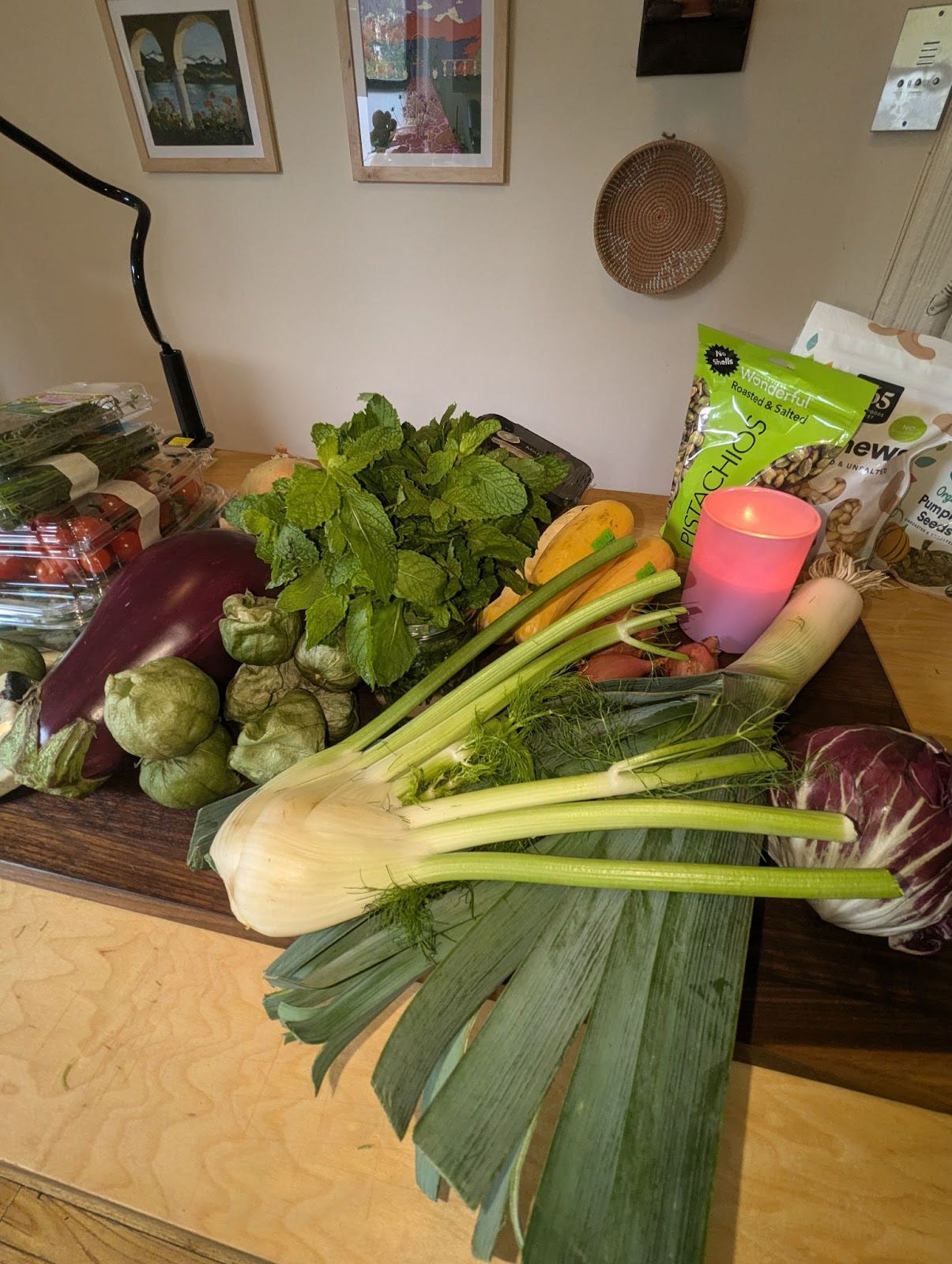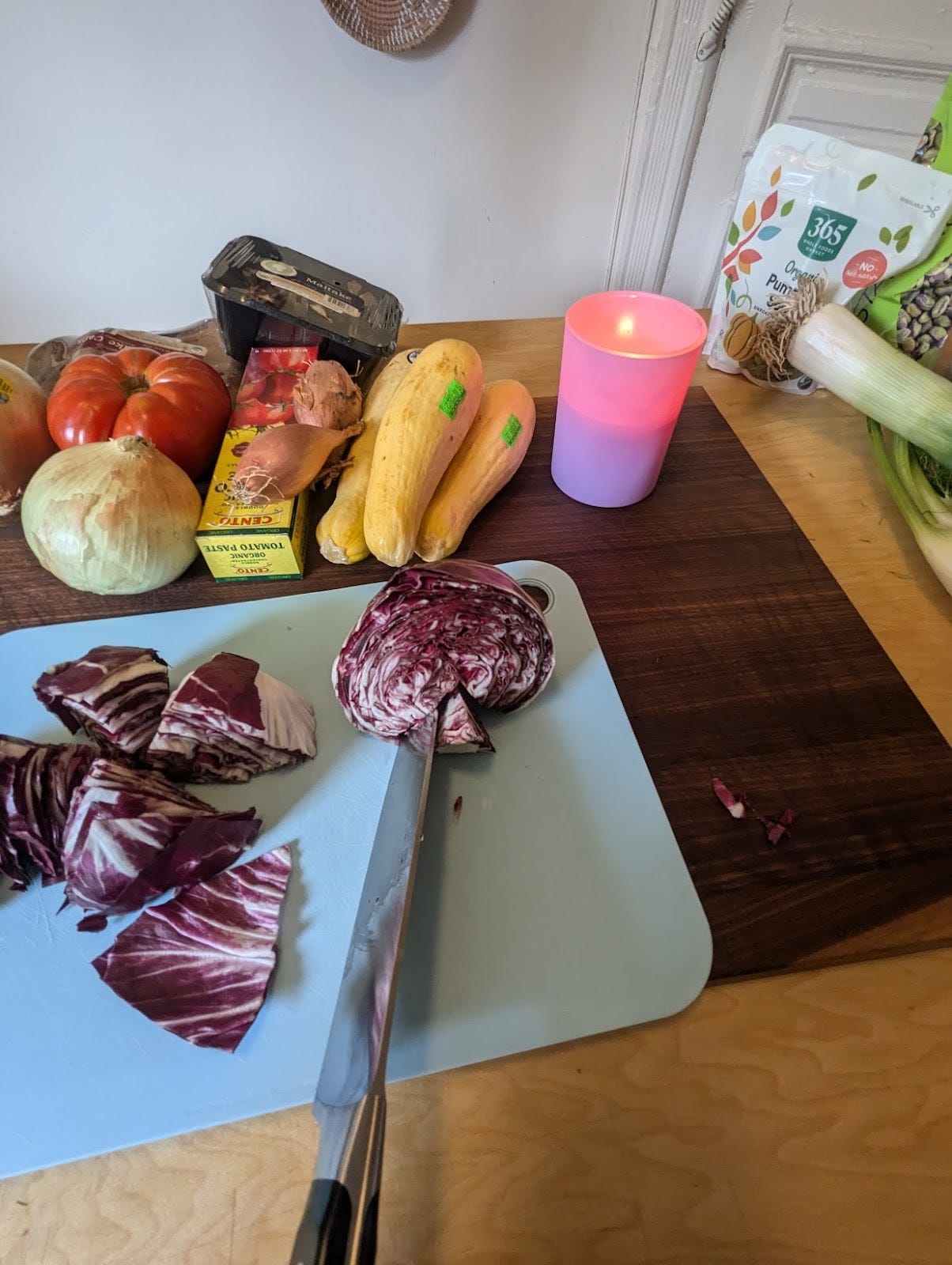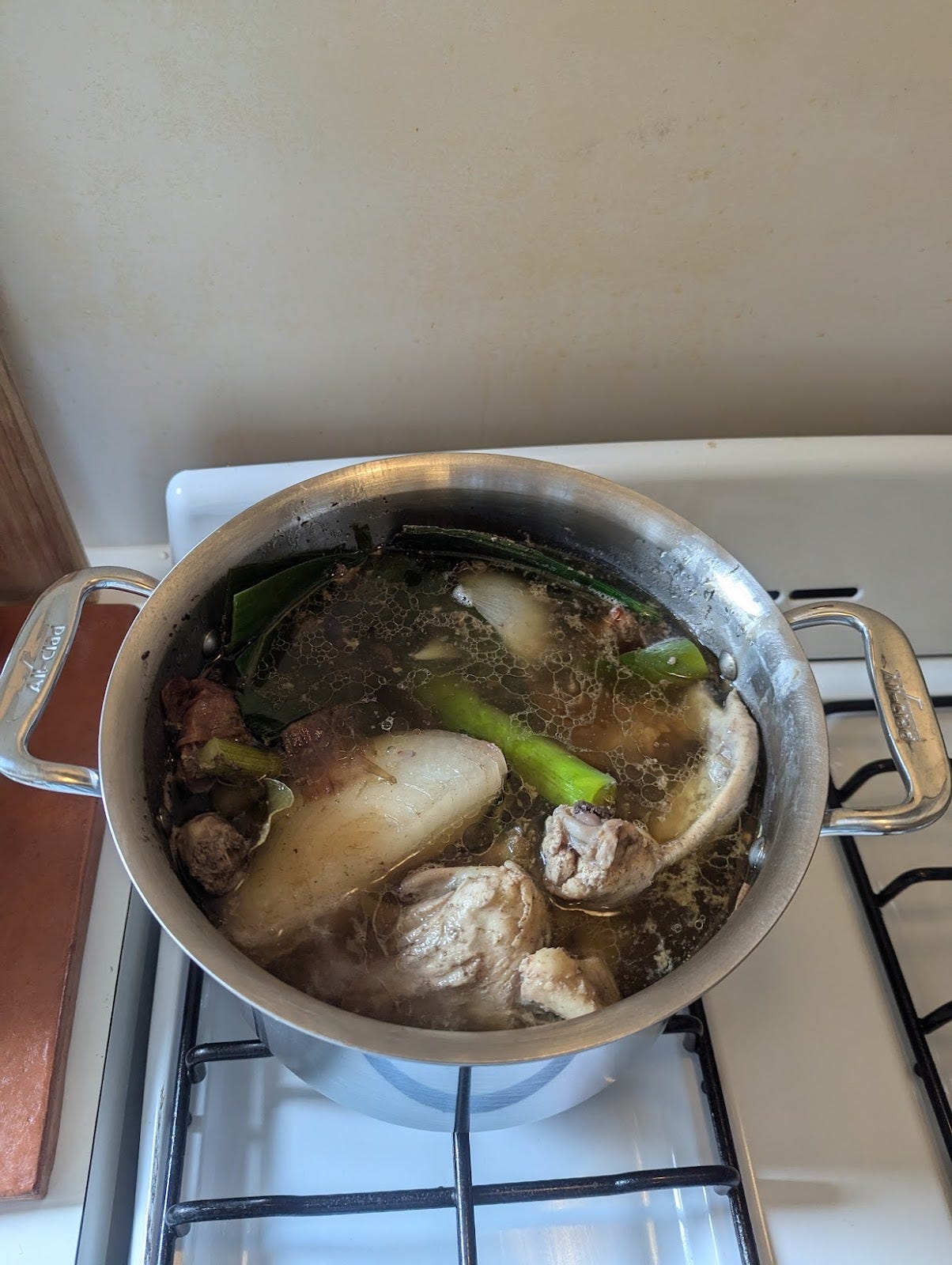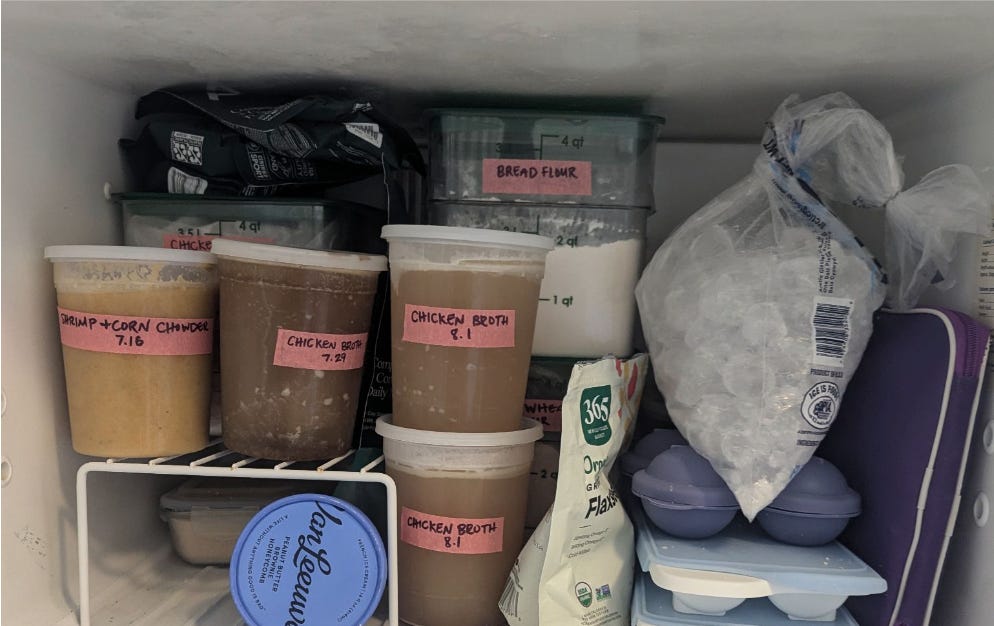Eva's Excellent Fridge-venture
My most triumphant process to plan meals, store food, and prevent waste.
I thought this newsletter was about systems of food storage and maintenance, but I think it might actually be about time travel.
Deciding to take action right now for the sake of your future experience can be chalked up to the role habits play in our lives. I love cooking, but there are times when planning meals, or dragging myself to the store, or trying to responsibly organize my food…AGAIN, feels like I’m running through mud. But when I’m able to quickly cook a meal I don’t thank the gods of habit for what I’m able to accomplish — instead I’m grateful to my past self for having the sense of responsibility to help take care of my future.

Today I’ll cover
Planning meals
Saying no to Doordash
Processing produce/Washing & Storing Methods
Ethylene Gas
Non-produce Preparation
Before you continue, I want to start off with a reminder of how lucky a lot of us are to be able to have consistent and convenient access to food. To turn feelings of guilt and anger around this into something productive, I try to have gratitude for the access I get to experience. I also think it’s important to take this opportunity to anyone who’s reading to consider donating to your local food pantry or sending money to World Central Kitchen who help people in catastrophic situations.
I realize how boring this topic might be to a lot of people, but I am constantly adjusting how I decide to organize my fridge and pantry. I won't be coy about the pride I take in the construction of this system because it takes a lot of work and finessing, especially when working in smaller kitchens. Some of what I’ve learned came from watching The Bear and not letting myself tear the masking tape when labeling food, or the 1 week I worked in a restaurant and saw how not to organize a fridge. But mostly it’s been trial and error with an undercurrent of desire to learn more about food and how not to waste it.
There are 2 barriers I experience that I’ve tried to reframe when it comes to the overall goal of reducing my food waste: 1) How can I buy things I’ll actually want to cook and eat, and 2) How can I avoid ordering out?
Planning meals I’ll actually want to eat.
It feels natural to start with the act of planning, to come up with a list of items to get from the store that will satisfy and nourish. A barrier I used to encounter when coming up with such lists was, How will I know what I want to eat next week? I have no idea what to get?... Now, there are a few questions I ask myself when I’m planning for food:
What do we already have in the fridge/pantry and will it still be good well into next week? (If it’s gone bad or about to go bad, throw it out or plan to use it that day or the next.)
What’s in season? Out of those options, what am I craving?
If I could eat anything right now, what would it be?
Are there 2-3 recipes (usually side dishes) I’ve been wanting to try?
The answers to these questions fall into a system I’ve come to. I don’t want to make rigid predictions about what I’ll be in the mood for, but I want to create a context in which I’m able to flexibly create meals based on those questions I answered. It’s like deciding what colors will go in my palette and it’s up to me how they’ll work together and in what context once I actually get to painting.
Based on those questions, I’ll write some initial ideas, perusing cookbooks and writing down whatever’s interesting. Then, I categorize my shopping list by food “type” in the order my grocery store is physically laid out — produce, protein, dairy, baked goods, grains, misc. I’ve tried integrating Chat GPT in this process to help categorize recipe ingredients, but I found the time I was saving (if that’s the goal) was nominal.
Breaking the stronghold DoorDash has on me
I assume it’s not unique to me that I’ll finish with work for the day, stand in front of the fridge clueless, and unconsciously open the Doordash app. There’s been a load of talk about the solution to this as meal prepping. But still, meal prepping requires a lot of upfront work and you better be okay with last week’s decision as you preheat that chicken and rice for the fourth day in a row.
I’m glad this works for some people, but it really weirds me out. Not just in terms of food safety but also because I’m not a robot who’s unconcerned with variety. To me, ingredient prepping makes so much more sense and guarantees getting a lot more life out of the produce you’ve bought while making it easier to actually cook. Like meal prepping, it does front load a lot of the labor in a larger chunk of time, but later on your cooking time and effort is significantly reduced.
How much easier it is to pull a container of already washed and cut radicchio out of the fridge vs. a much more daunting whole head of radicchio waiting to be prepped. How lovely it is that you made a batch of salad dressing that will be poured into a bowl containing ingredients like green leaf lettuce, dill and sliced cucumber that were already washed, dried and stored in your fridge!
I love preparing ingredients in this way because it provides the constraints I need when cooking (these are the things you have available) while still being creative when I cook (these are the ways you can incorporate them).
Processing Produce - How I Do It
After I get my produce, I light a candle, queue up a podcast and lay it all out on the table to see my beautiful, bodacious bounty.
Usually I’ll start with the biggest, leafiest things to get them out of the way while also looking for opportunities to freeze components that would make good additions to broth, like fennel bulb stalks and leaves from leeks or anything else that makes sense. This week I came to terms with my having x6 1-quart containers filled with frozen chicken parts, so I made a huge batch of broth while I worked through the produce.
Washing & Storing Methods
Separate batches of things like lettuces, kale, grapes, and berries get soaked in a bath with a mix of water and a small pour of distilled white vinegar, then are drained, rinsed, spun, and stored in a 4 or 6 qt container with a tea towel lining the bottom to catch any residual water. I’ve found that stored this way, produce can usually last up to 2 weeks. (When I buy pre-washed lettuce I’ll add a paper or tea towel to the bottom of the container it came in to catch any excess moisture.)
For herbs like parsley and cilantro I wash them as I do the above, but stored in an upright container filled with water, wrapped in a paper towel and covered with a gallon ziplock back, left open (I also rewash these baggies so they don’t go to waste after 1 use).
For big bunches of herbs like mint and dill I won’t wash them beforehand and will only store them in the same way as the herbs I’ve already mentioned. I find that if they’re washed beforehand they wilt very quickly and the mint, especially, turns black. For herbs that come in pre-packaged containers, I’ll wrap them in a paper towel and leave in the packaging.
At the end of processing everything this week, I had containers of washed kale, radicchio, red leaf lettuce, grapes, cherries, strawberries, mint, and parsley all ready to be chopped, sliced or eaten throughout the week. These are also the things that tend to wilt, release water and get soggy, grow mold, etc. if they’re left on their own and which I prioritize over more stable produce.
Ethylene Gas
I recently learned about ethylene gas. It gets produced by fruit and vegetables as they ripen and can cause other produce to wilt or go bad prematurely. If an ethylene producer like bananas sits next to an ethylene sensitive product, like potatoes, then that potato will start to sprout earlier than it would if it were sitting on its own or with another non-ethylene producing fruit/vegetable. This is also helpful to know if you want to speed up the ripening of your avocados or bananas for banana bread (because who is honestly eating a banana for the sake of eating a banana?). I don’t think this is as big of a deal with produce in the fridge as with produce on the counter since room temperatures are a perfect environment for bacteria and growth. With that said, I have a smaller Brooklyn kitchen and my counter space is precious, so sometimes you will see a banana sitting next to a tomato — sue me!
Non-Produce Preparation
If there’s still produce that looks (and smells) like it’s holding up well, I’ll try to use what I can and find that this is also a good way to explore and create with food. This week I made a tangy scallion dressing that I’ve been putting on all different kinds of salads and even roasted corn.
Buttermilk
Olive oil
Lemon juice & white wine vinegar
4-5 scallions (white & green parts)
capers
1-2 anchovy filets
pepper
I’ve been binge-cooking Kismet’s cookbook and one of my favorite things from it has been their marinated feta. Having this on hand has been a game changer because it tastes great eaten with a spoon or with pretty much anything else.
I always have chicken broth in the freezer because I break down whole chickens almost every week. Every season is soup season!
Let’s Wrap This Up…
Cooking is one of the most creative things you can do, but that doesn’t mean it needs to be chaotic or unplanned. In fact, having order in your kitchen can only help during those times of creative play. A chef I recently worked with said, “cooking is cleaning.” Hot. But cooking is also staying organized by creating good conditions for yourself now and later.
If you’ve made it this far then we’re probably very compatible. Let’s go grab a drink.








